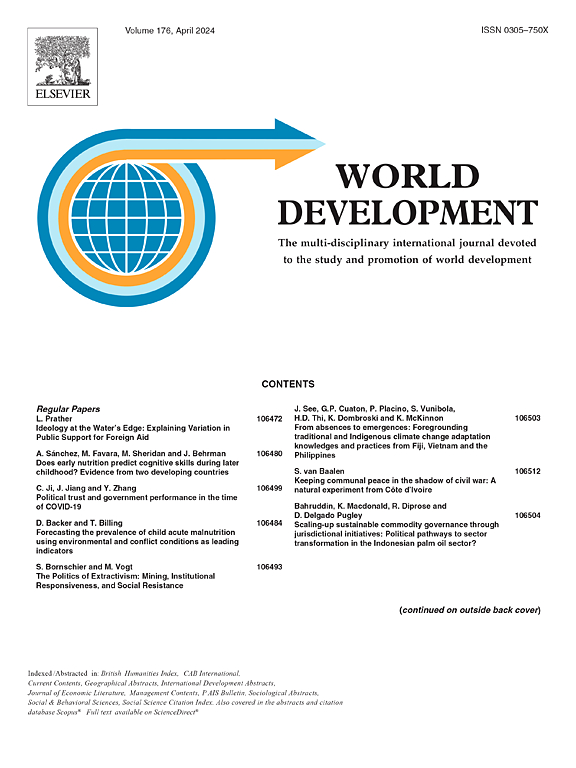Adolescence, Interrupted: A narrative review of the impact of Covid-19 on adolescent wellbeing
IF 5.4
1区 经济学
Q1 DEVELOPMENT STUDIES
引用次数: 0
Abstract
The Covid-19 pandemic has had far-reaching impacts across the globe, with divergent experiences across the life course. Although mortality and morbidity effects have been disproportionately felt among older generations, there is growing recognition that adolescents have also faced multidimensional consequences, fueled by closure of schools and recreational spaces, and widespread disruption to services. While much has been written about the educational and health effects of the pandemic on adolescents, less attention has been given to other aspects of their wellbeing.
This narrative review therefore summarizes the current evidence on the effects of the pandemic on adolescent wellbeing. We draw on the United Nations (UN) H6 + Technical Working Group on Adolescent Health and Well-being’s conceptualization of adolescent wellbeing (Ross et al., 2020), focusing on three domains: connectedness, positive values and contribution to society; safety and a supportive environment; and agency and resilience. Drawing on both peer-reviewed and grey literature from high-, middle- and low-income contexts, we focused our search on adolescents (aged 10–19) and Covid-19 pandemic-related effects on wellbeing in these three domains. We also highlight findings related to three groups of adolescents who have often been overlooked in the literature on the impact of the pandemic: adolescent refugees, married adolescents, and adolescents with disabilities.
We searched using Google Scholar, PubMed and Scopus, as well as working paper series at the National Bureau of Economic Research (NBER) and the World Bank, to identify published and grey literature across the three domains of interest. We restricted the search to articles that presented new, original data, included adolescents (aged 10–19), and were published in English, between January 1, 2020 and April 30, 2022. We expanded the search to make use of the bibliographies uncovered through this review to check for other citations that might meet the search criteria.
The search yielded 193 articles on adolescent wellbeing in the three domains of interest during the Covid–19 pandemic. Adolescents in high-income countries (HICs) were overrepresented compared to those in low- and middle-income countries (LMICs) (126 vs. 60 articles). Furthermore, more articles focused on social connectedness (117 studies) than on adolescent wellbeing in terms of agency and resilience (73 studies) and safety and a supportive environment (61 studies).
Nearly three years after the Covid-19 pandemic’s onset, the literature on adolescent wellbeing highlights the multiple and intersecting challenges that adolescents faced, especially those living in LMICs. Service disruptions (notably school closures) combined with financial stress, heightened vulnerability to age- and gender-based violence, and social isolation placed unprecedented pressures on young people, taking a toll on their physical and mental health. Evidence that the pandemic has exacerbated existing inequalities – with the most vulnerable adolescents (such as refugees, adolescents with disabilities and married girls) seemingly worst affected – is particularly salient for policy makers. While many adolescents are finding ways to cope (by relying on family and teacher support, connecting with peers through online networks or volunteering), understanding how to promote adolescent resilience more effectively – particularly in LMIC contexts – will be essential to ensure a rapid post-Covid-19 recovery.
青春期,中断:Covid-19 对青少年福祉影响的叙述性回顾
Covid-19 大流行在全球范围内产生了深远的影响,整个生命过程中的经历各不相同。虽然死亡率和发病率对老一代人的影响尤为严重,但越来越多的人认识到青少年也面临着多方面的后果,学校和娱乐场所的关闭以及服务的广泛中断更是雪上加霜。尽管有关大流行病对青少年教育和健康影响的文章已经很多,但对青少年福祉的其他方面却关注较少。因此,本综述总结了目前有关大流行病对青少年福祉影响的证据。我们借鉴了联合国(UN)青少年健康与福祉 H6+ 技术工作组对青少年福祉的概念(Ross et al.我们借鉴了来自高、中、低收入国家的同行评审文献和灰色文献,重点搜索了青少年(10-19 岁)以及 Covid-19 大流行对这三个领域的福祉的影响。我们还重点研究了在有关大流行影响的文献中经常被忽视的三个青少年群体:青少年难民、已婚青少年和残疾青少年。我们使用谷歌学术、PubMed 和 Scopus 以及美国国家经济研究局 (NBER) 和世界银行的工作论文系列进行搜索,以确定三个相关领域的已发表文献和灰色文献。我们将搜索范围限定在 2020 年 1 月 1 日至 2022 年 4 月 30 日期间,以英文发表的、提供新的原创数据、包含青少年(10-19 岁)的文章。我们扩大了搜索范围,利用本次综述中发现的书目来检查其他可能符合搜索标准的引文。搜索结果显示,共有 193 篇文章涉及 Covid-19 大流行期间青少年在三个相关领域的健康状况。与中低收入国家(LMICs)的青少年相比,高收入国家(HICs)的青少年所占比例更高(126 篇文章对 60 篇文章)。此外,更多文章关注社会联系(117 篇研究),而不是青少年在机构和复原力(73 篇研究)以及安全和支持性环境(61 篇研究)方面的福祉。在 Covid-19 大流行爆发近三年后,有关青少年福祉的文献强调了青少年面临的多重交叉挑战,尤其是生活在低收入和中等收入国家的青少年。服务中断(尤其是学校停课)、经济压力、更容易遭受年龄和性别暴力以及社会隔离等因素给青少年带来了前所未有的压力,使他们的身心健康受到损害。有证据表明,疫情加剧了现有的不平等--最脆弱的青少年(如难民、残疾青少年和已婚女孩)似乎受到了最严重的影响--这对政策制定者来说尤为突出。虽然许多青少年正在寻找应对方法(依靠家庭和老师的支持、通过在线网络与同伴建立联系或参加志愿活动),但了解如何更有效地提高青少年的抗击能力--尤其是在低收入和中等收入国家--对于确保19病毒肆虐后的快速恢复至关重要。
本文章由计算机程序翻译,如有差异,请以英文原文为准。
求助全文
约1分钟内获得全文
求助全文
来源期刊

World Development
Multiple-
CiteScore
12.70
自引率
5.80%
发文量
320
期刊介绍:
World Development is a multi-disciplinary monthly journal of development studies. It seeks to explore ways of improving standards of living, and the human condition generally, by examining potential solutions to problems such as: poverty, unemployment, malnutrition, disease, lack of shelter, environmental degradation, inadequate scientific and technological resources, trade and payments imbalances, international debt, gender and ethnic discrimination, militarism and civil conflict, and lack of popular participation in economic and political life. Contributions offer constructive ideas and analysis, and highlight the lessons to be learned from the experiences of different nations, societies, and economies.
 求助内容:
求助内容: 应助结果提醒方式:
应助结果提醒方式:


